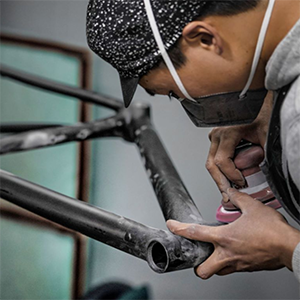
How Much Do You Know About Carbon Fiber Bicycles?
What we often call "carbon fiber" is actually "carbon fiber composite material", which is a high-performance composite material formed by curing carbon fiber with resin (usually epoxy resin). In carbon fiber composite materials, in addition to the carbon fiber itself, the quality of epoxy resin also plays a vital role in the performance of carbon fiber composite materials.
In the bicycle industry, carbon fiber composite materials have the advantages of high strength, light weight, and high plasticity compared to other common metal materials on bicycles. More importantly, the anisotropy of carbon fiber itself is very suitable for use in sports equipment such as bicycle frames with more complex force directions. For example, in the rear seat fork area that requires better vertical flexibility and the five-way area that requires higher rigidity in all directions, the specific rigidity and vertical flexibility requirements of each part can be achieved by using carbon fibers of different moduli and stacking methods in different directions.

In addition to carbon fiber, aluminum alloy is also a common material for racing road frames on the market. You may ask, Which one should I buy? What are the advantages and disadvantages of carbon fiber and aluminum alloy frames?
It is reasonable for you to have such doubts. Experts believe that the difference between carbon fiber road bikes and aluminum alloy road bikes cannot be simply judged by "which one is better". Which one you should buy should also be determined by your specific personal needs and preferences. So, let us first take a brief look at some of the characteristics of carbon fiber and aluminum alloy.
Generally speaking, carbon fiber frames of the same type and size are easier to get lighter than aluminum alloy frames. However, the density of aluminum alloy is 1.75-1.93g/cm³, while the density of aluminum alloy is 2.5-2.88g/cm³. Therefore, the multiple tube drawing technology is generally used to reduce the tube wall thickness to effectively reduce the weight of the frame, approaching or even reaching the level of some carbon fiber frames.
In addition, the tensile strength of aluminum alloy is generally 160-400MPa, and the tensile strength of aluminum alloy after heat treatment can reach 700MPa; while carbon fiber has a lower density, the tensile strength can reach 3000MPa, and the specific stiffness and specific strength of properly designed carbon fiber materials are much higher than those of heat-treated aluminum alloy. Therefore, we can assume that, in general, a properly designed carbon fiber frame has a higher frame rigidity than an aluminum alloy frame. Of course, the aluminum alloy frame can also be reasonably designed to strengthen the rigidity of specific parts while maintaining a certain weight.
As a product with a relatively high material price and a relatively complex production process, generally speaking, the price of carbon fiber bicycles will be higher than that of metal frame bicycles, such as aluminum alloy and steel. However, the higher prices of most carbon fiber bicycle products with the highest brand positioning are not entirely determined by the carbon fiber material itself. High-performance frame design, equally high-performance accessories, and even fine painting are all part of the value of a bicycle. Of course, you can also find carbon fiber bicycles suitable for beginners.
Like all other products, carbon fiber bicycles have undergone rigorous performance and safety tests before leaving the factory. On this basis, the design weight limit of a product is related to its material, structure, use, etc., and will not change because it is made of carbon fiber. For the specific weight limit of each product.
Carbon fiber is not like some people think that partial damage means that the entire frame is scrapped. If a carbon fiber frame is damaged, it can be repaired with new carbon fiber materials. Of course, you need a professional carbon fiber repair team to ensure the safety of the repaired product.

In theory, the ultraviolet rays from the sun will have a certain impact on the aging of epoxy resin, but this is only theoretical. In real life, there is no need to worry too much about this. Oxygen, humidity, ultraviolet rays, etc., will cause changes in epoxy resin, but in normal use, the impact of these factors is minimal. We recommend that carbon fiber bicycles be parked in a cool and dry environment for a long time, but in daily use, there is no need to worry about the impact of the environment on carbon fiber. Please enjoy outdoor riding!
Précédente :
Carbon Wheel Maintenance TipsSuivante :
Carbon Mountain Bike vs Aluminum Mountain Bike: Which is Right for You?Catégories
Nouveau blog
droits dauteur © 2025 Top-Fire Carbon Technology Co., Ltd. Tous les droits sont réservés. Mettre au courant

Réseau IPv6 pris en charge